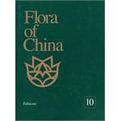中国植物志
出版时间:2010-2 出版社:科学出版社 作者:Flora of China Editorial Committee 等著 页数:642
前言
Volume 10 of the Flora of China is the 18th of the 24 text volumes in the series. It includesone family, 29 tribes, 167 genera, and 1,673 species, among which one genus and 690 species(41%) are endemic to China, and three or four tribes, 32 or 33 genera, and 131-134 species (8%)are introduced to China. Volume 10 is formatted in the same manner as the first 17 volumes of the series: vol. 17(1994), vol. 16 (1995), vol. 15 (1996), vol. 18 (1998), vol. 4 (1999), vol. 24 (2000), vol. 8 (2001),vol. 6 (2001), vol. 9 (2003), vol. 5 (2003), vol. 14 (2005), vol. 22 (2006), vol. 13 (2007), vol. 12(2007), vol. 11 (2008), vol. 7 (2008), and vol. 25 (2009). The following 16 accompanyingvolumes of the Flora of China Illustrations have been published to date: vol. 17 (1998), vol. 16(1999), vol. 15 (2000), vol. 18 (2000), vol. 4 (2001), vol. 24 (2002), vol. 8 (2003), vol. 6 (2003),vol. 9 (2004), vol. 5 (2004), vol. 14 (2006), vol. 22 (2007), vol. 13 (2008), vol. 12 (2008), vol. 11(2009), and vol. 7 (2009). Bruce Bartholomew co-authored and edited the Hedysareae (Eversmannia), Robinieae, andSesbanieae and edited the Aeschynomeneae, Crotalarieae, Galegeae (Oxytropis), Hedysareae (ex-cept ,4lhagi, Calophaca, and Halimodendron), and Millettieae. Anthony R. Brach co-authoredand edited the Galegeae (Gueldenstaedtia and Tibetia) and edited the Acacieae, Caesalpinieae,Cassieae, Cercideae, Dalbergieae, Desmodieae, Detarieae, Euchresteae, Galegeae (except As-tragalus, Oxytropis, and Phyllolobium), Hedysareae (Alhagi, Calophaca, and Halimodendron),Ingeae, and Mimoseae. Michael G. Gilbert co-authored and edited the Abreae, Amorpheae, andPsoraleeae, edited and partly co-authored the Phaseoleae, and edited the Indigofereae. Lisa J.Pepper and Nicholas J. Turland edited the Fabeae (Lathyrus), Galegeae (Astragalus and Phyl-lolobium), Loteae, Sophoreae, Trifolieae, and Thermopsideae.
内容概要
This volume entirely comprises the legume family (Fabaceae or Leguminosae), with 1,673 species in China, of which 690 are endemic, i.e., found nowhere else on Earth. The legumes of China are divided into 29 tribes, starting with the Cercideae, which include the disjunct redbuds (Cercis) and pantropical Bauhinia, and finishing with the Fabeae, which include vetches (Vicia), vetchlings (Lathyrus), lentil (Lens culinaris), and pea (Pisum sativum). The largest legume genus in China is Astragalus, with 401 species (it is also the largest genus globally, with ca. 3,000 species), followed by Oxytropis (133 species), Indigofera (79 species), in which I. tinctoria and I. suffruticosa are sources of the dye indigo, and Caragana (66 species).
书籍目录
PrefaceIntroductionAcknowledgmentsFabaceae 豆科dou keList of Nomenclatural Novelties Published in this Volume of the Flora of ChinaIndex to Chinese NamesIndex to Pinyin NamesIndex to Scientific NamesIndex to Families in the Flora of China and the Flora Reipublicae PopuIaris SinicaePublished Volumes of the Flora of China and the Flora of China Illustrations
章节摘录
Lianas, woody, with tendrils; whole plant glabrous exceptfor pedicel base and leaf buds. Twigs slightly zigzag, slender;tendrils solitary, slender. Leaves 2-foliolate; stipules caducous;petiole 1-2 cm, slender, glabrous; leaf blade 12-24 x 9-16 mm,membranous, abaxially thinly pubescent on axils of primaryveins, adaxially glabrous, veins 3 per lobe, veins dense, salienton both surfaces, base truncate; lobes obliquely obovate, apexobtuse or rounded. Inflorescence corymbose-racemose, termi-nal on lateral branches, many flowered; peduncle more than 1cm; bracts and bracteoles linear, 1.5-4 mm. Pedicel 1-3 cm,slender. Flower buds ellipsoid, ca. 5 mm. Receptacle cylindric,10-12 mm; calyx lobes 5, reflexed, broadly ovate or lanceolate.Petals white, broadly obovate, ca. 9 ~ 6 mm, abaxially hairynear base, shortly clawed. Fertile stamens 3; filaments ca. 1 cm,glabrous. Staminodes 3-5. Ovary shortly stalked, glabrous;style short; stigma disciform. Legume strap-shaped, com-pressed, ca. 10x 2.5cm, tardily dehiscent, glabrous, suturesslightly thickened. Seeds ellipsoid, compressed, ca. 6 x 4 mm;testa brown. FI. Aug-Dec, ft. Sep-Feb.
媒体关注与评论
"…a landmark series of volumes" ——Economic Botany "…a must for any student of the temperate and subtropical flora of such a vast. species-rich country.." ——Kew Bulletin "…an indispensable tool for identifying Chineseplants..." ——Systematic Botany
图书封面
评论、评分、阅读与下载
